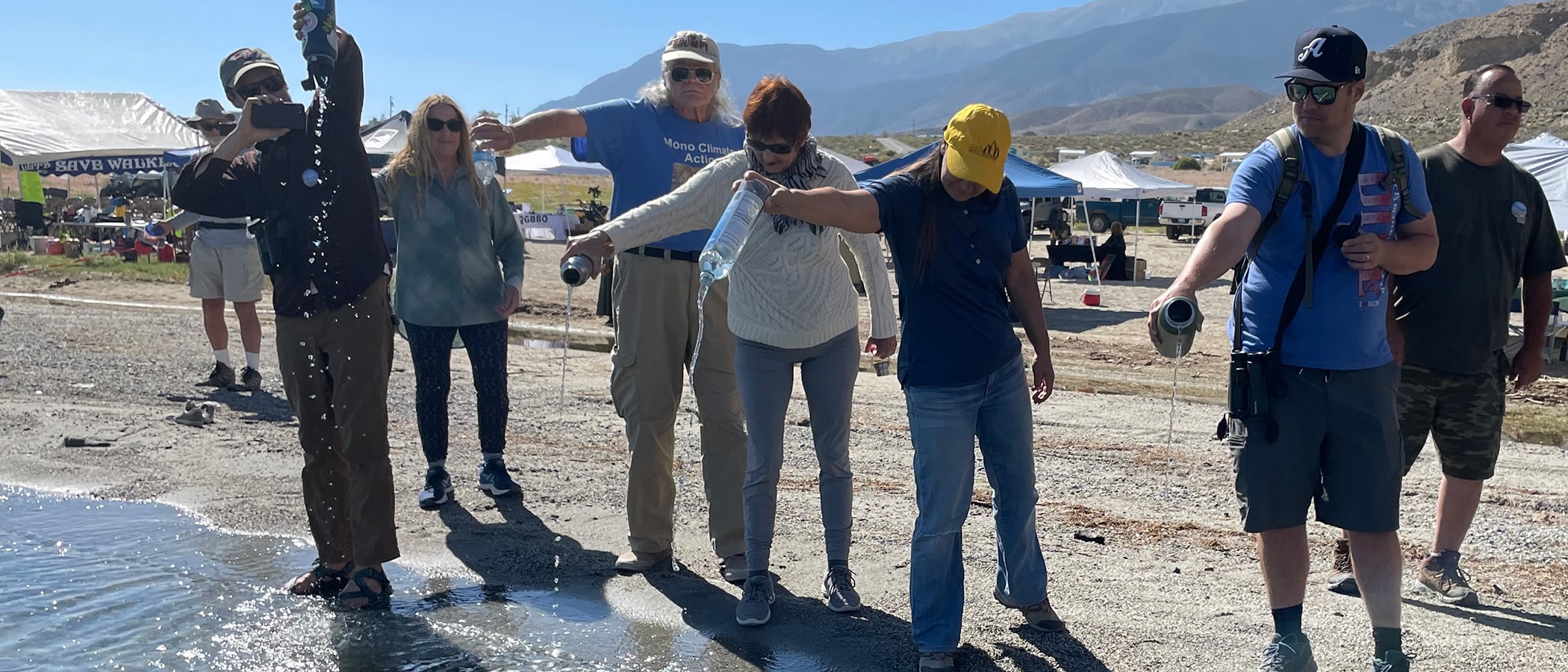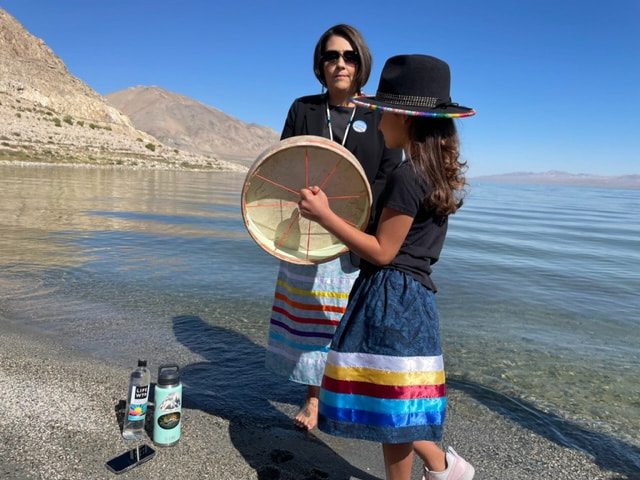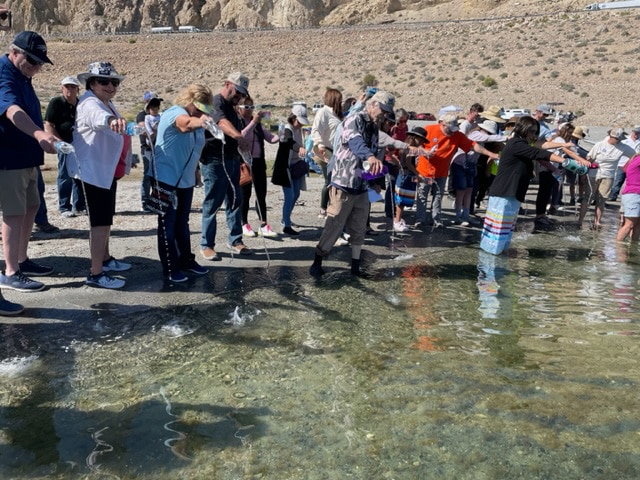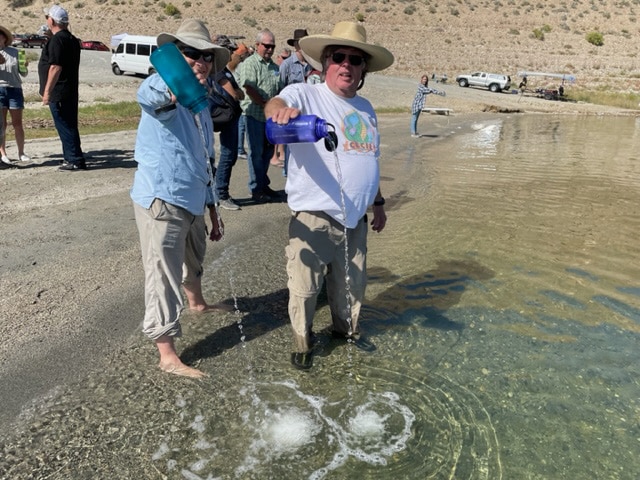
The Walker Lake Working Group’s Rehydration Celebration, held September 23rd, not only acknowledged nature’s generosity in raising Walker Lake 15 vertical feet, but also raised the hopes of those who have been fighting to restore it for more than three decades. Visitors came from as far away as Sacramento to hear an inspiring selection of speakers and participate in a stirring rehydration ceremony.
The event opened with a moving prayer in her native language from Andrea Martinez, Walker River Paiute Tribal Chair. Lorna Weaver, longtime Walker Lake Working Group member, issued a warm welcome expressing gratitude to all those who helped the lake’s preservation efforts in the past. Richard Potashin, one of the Working Group’s newest members, escorted the crowd to the shore for the rehydration ceremony, where the crowd was drawn into the true meaning of the day.

Gabby, Andrea’s daughter, played a traditional drum and sang about a time when pelicans flew over the lake. With waves lapping around their ankles, Andrea and Richard shared their personal connections to Walker Lake. Andrea seemed to bring the lake alive, evoking the lake’s Paiute name Agai Pah meaning “Trout Lake,” a reference to the large Lahontan cutthroat trout that lived in the lake. Her ancestors lived around the lake and relied on its fish and bird populations for food. They were known as the Agai Ticutta or “Trout Eaters.” Richard described his connection to Walker Lake’s sister lake, Mono Lake. “Walker Lake is not a lost cause and we must continue the fight to restore it as a viable ecosystem,” he said. The crowd then raised their water bottles in solidarity and emptied the contents, symbolically raising the lake.

The remainder of the day was filled with additional hope and presentations about Walker Lake’s extraordinary natural history. Dr. Phillip Garone, history professor from California State University Stanislaus, spoke about the lake’s inception as part of ancient Lake Lahontan and traced its precipitous decline due to upstream agricultural development. Carlie Henneman, the Walker Basin Conservancy’s Water Program Director, explained the Conservancy’s past successes in acquiring water rights and its ongoing efforts to obtain more water for the lake. Her message—become educated and get involved.
Following a short break, Ned Bohman from the Great Basin Bird Observatory confirmed through recent observations that Walker Lake remains full of bird life. Although some species await a rise in water levels and the return of native fishes, other species like grebes, Ruddy Ducks, and coots are satisfied to take advantage of current conditions. The final speaker, Mike Sevon, retired fisheries biologist for the Nevada Department of Wildlife, livened up the day with his harmonica and spirited rendition of “the Walker Lake Blues.” Much of Sevon’s career was dedicated to working with Walker Lake’s native fishes. Although he bemoaned the sadness of losing a unique fishery, he shared a positive vision for the lake’s future. “With increased water levels, lower total dissolved solid levels, and access to local refugia, the prized Lahontan cutthroat trout and tui chub could be successfully reintroduced,” he told the audience. “We can hope and work toward that outcome,” he added.
The rehydration event also acknowledged the contributions of longtime Walker Lake Working Group members, Glenn Bunch, President and Marlene Bunch, Treasurer with a special award. The award was well-deserved considering the Bunches have worked for more than 30 years fighting the good fight to save and restore Walker Lake. And this day was no exception as Glen and Marlene were at the Working Group booth selling swag and raffle tickets and answering questions.
Dozens of event goers toured the lake aboard canoes provided by the Mono Lake Committee and guided by current and former Mono Lake Committee staff members. “They really know their stuff,” was heard from one delighted participant as they disembarked from a canoe.

Other participants created trout prints, painted rocks, or had their faces painted assisted by local volunteers. No one went hungry as the Working Group offered hot dogs to any and all for a nominal donation.
The successful event generated more than $2,000 in donations and additional memberships for the Working Group, two factors critical to continuing their work in restoring the lake. The educational benefits were priceless, as attendees left the event with a sense of hopefulness knowing the lake is not and never will be a lost cause.
However, the fight is not over and you too can still get involved. Donations can be made to the Walker Lake Working Group and to the Walker Basin Conservancy. You can also become a member of the Walker Lake Working Group and/or contact them to volunteer to assist with projects and/or events such as this one.
Long live Walker Lake!
This post was written by Richard Potashin, aka “Alkali Flat.” He is a co-founder of the Mono Lake Committee’s canoe tour program, a former Mono Lake Intern, and is an arborglyph expert along with his wife Nancy Hadlock. Top image courtesy of Richard Potashin.
